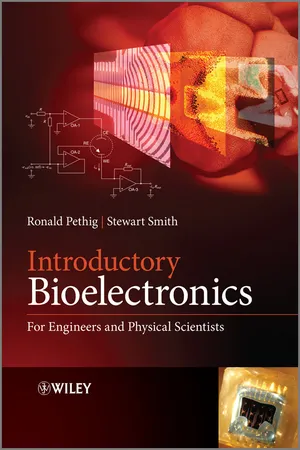
Introductory Bioelectronics
For Engineers and Physical Scientists
- English
- ePUB (mobile friendly)
- Available on iOS & Android
About this book
Bioelectronics is a rich field of research involving the application of electronics engineering principles to biology, medicine, and the health sciences. With its interdisciplinary nature, bioelectronics spans state-of-the-art research at the interface between the life sciences, engineering and physical sciences.
Introductory Bioelectronics offers a concise overview of the field and teaches the fundamentals of biochemical, biophysical, electrical, and physiological concepts relevant to bioelectronics. It is the first book to bring together these various topics, and to explain the basic theory and practical applications at an introductory level.
The authors describe and contextualise the science by examining recent research and commercial applications. They also cover the design methods and forms of instrumentation that are required in the application of bioelectronics technology. The result is a unique book with the following key features:
- an interdisciplinary approach, which develops theory through practical examples and clinical applications, and delivers the necessary biological knowledge from an electronic engineer's perspective
- a problem section in each chapter that readers can use for self-assessment, with model answers given at the end of the book along with references to key scientific publications
- discussions of new developments in the bioelectronics and biosensors fields, such as microfluidic devices and nanotechnology
Supplying the tools to succeed, this text is the best resource for engineering and physical sciences students in bioelectronics, biomedical engineering and micro/nano-engineering. Not only that, it is also a resource for researchers without formal training in biology, who are entering PhD programmes or working on industrial projects in these areas.
Frequently asked questions
- Essential is ideal for learners and professionals who enjoy exploring a wide range of subjects. Access the Essential Library with 800,000+ trusted titles and best-sellers across business, personal growth, and the humanities. Includes unlimited reading time and Standard Read Aloud voice.
- Complete: Perfect for advanced learners and researchers needing full, unrestricted access. Unlock 1.4M+ books across hundreds of subjects, including academic and specialized titles. The Complete Plan also includes advanced features like Premium Read Aloud and Research Assistant.
Please note we cannot support devices running on iOS 13 and Android 7 or earlier. Learn more about using the app.
Information
1.1 Chapter Overview
1.2 Energy and Chemical Reactions
1.2.1 Energy
1.2.2 Covalent Chemical Bonds







1.2.3 Chemical Concentrations
Table of contents
- Cover
- Title Page
- Copyright
- About the Authors
- Foreword
- Preface
- Acknowledgements
- Chapter 1: Basic Chemical and Biochemical Concepts
- Chapter 2: Cells and their Basic Building Blocks
- Chapter 3: Basic Biophysical Concepts and Methods
- Chapter 4: Spectroscopic Techniques
- Chapter 5: Electrochemical Principles and Electrode Reactions
- Chapter 6: Biosensors
- Chapter 7: Basic Sensor Instrumentation and Electrochemical Sensor Interfaces
- Chapter 8: Instrumentation for Other Sensor Technologies
- Chapter 9: Microfluidics: Basic Physics and Concepts
- Chapter 10: Microfluidics: Dimensional Analysis and Scaling
- Appendix A: SI Prefixes
- Appendix B: Values of Fundamental Physical Constants
- Appendix C: Model Answers for Self-study Problems
- Index